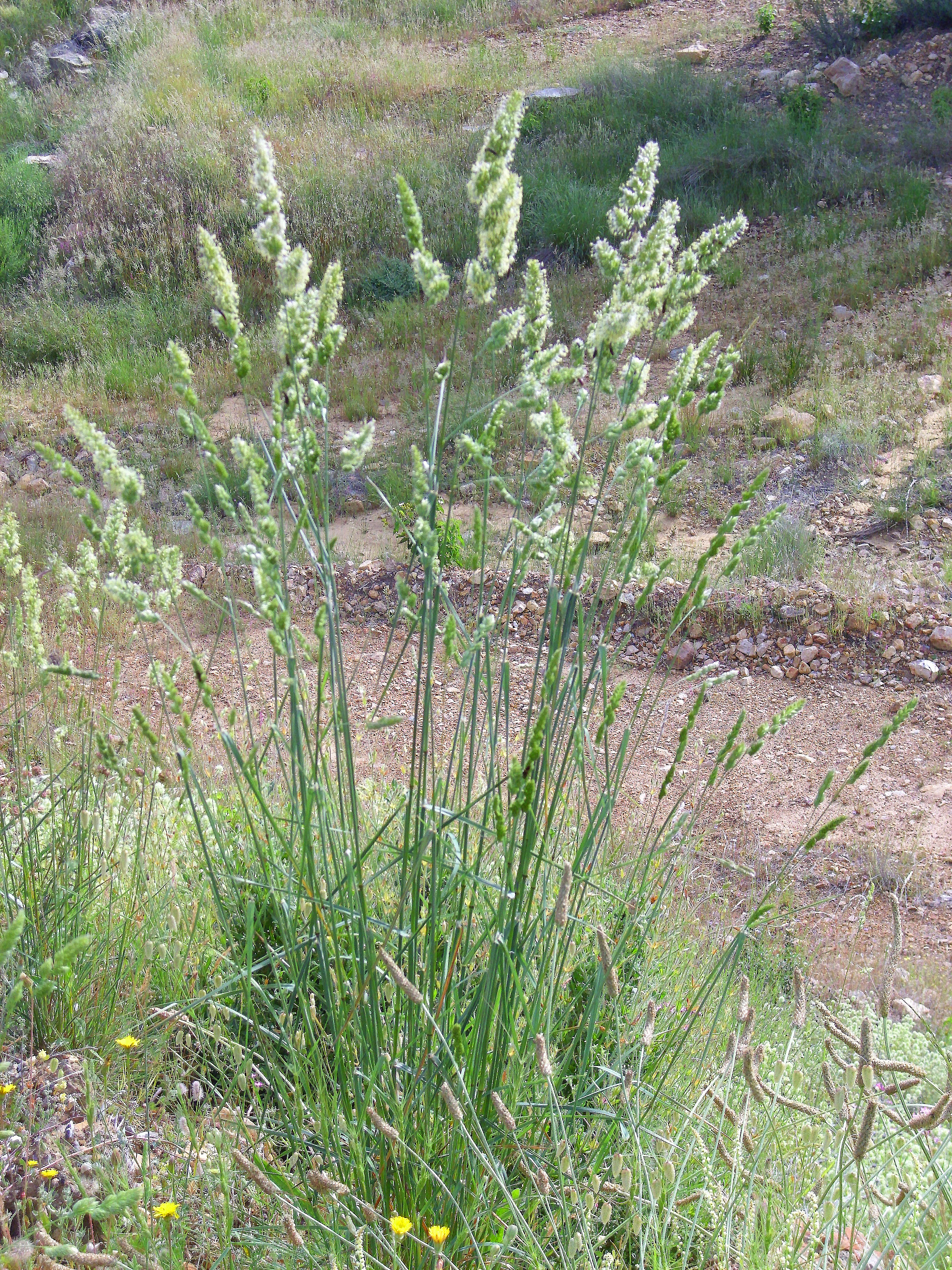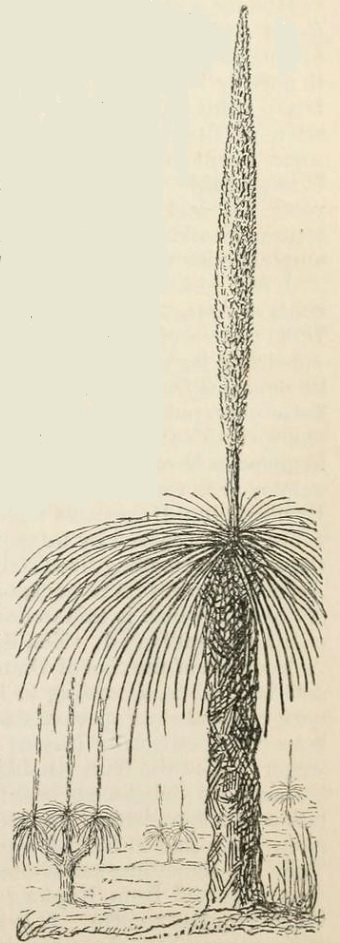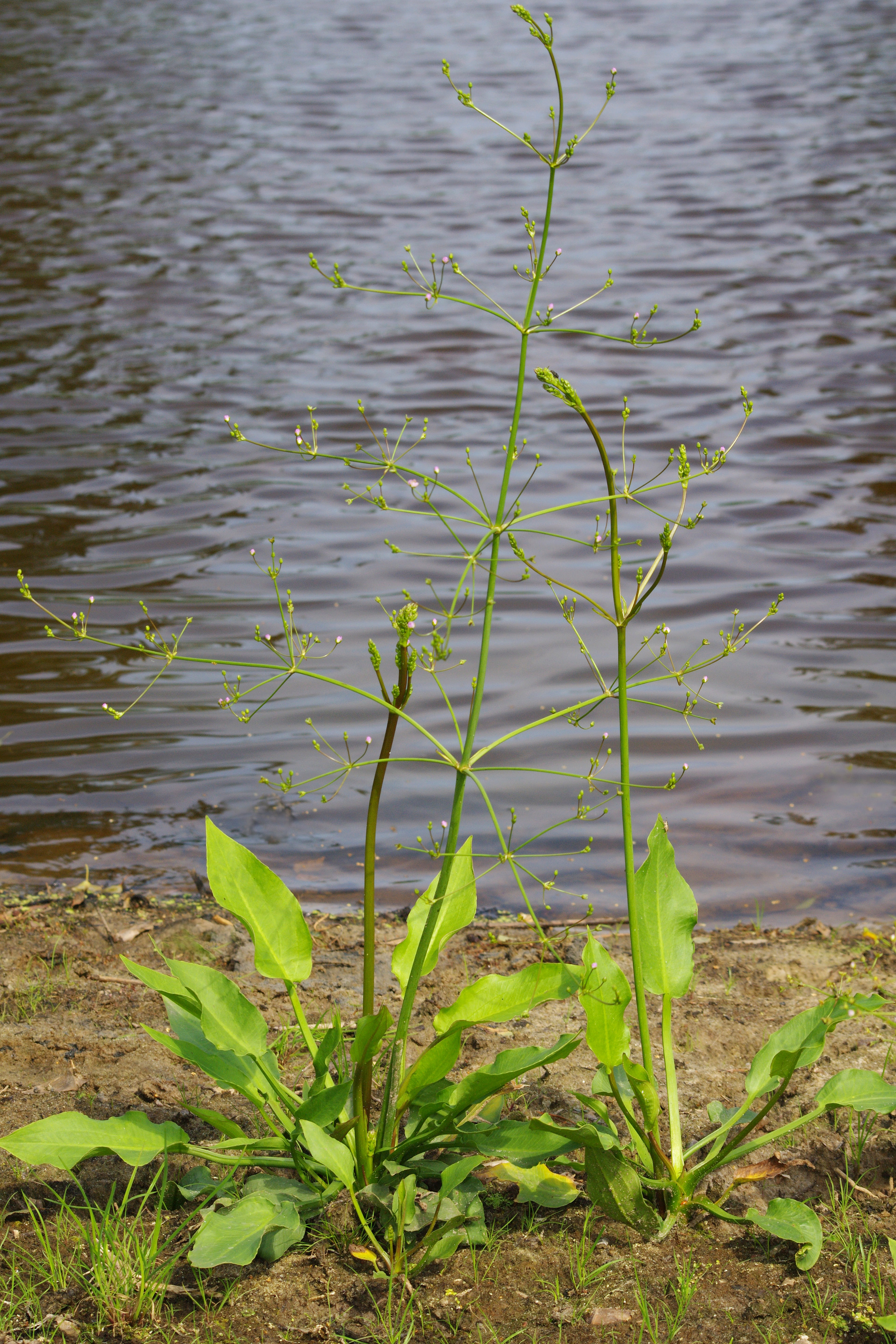|
Commelinid Monocots
In plant taxonomy, commelinids (originally commelinoids) is a clade of flowering plants within the monocots, distinguished by having cell walls containing ferulic acid. Well-known commelinids include palms and relatives (order Arecales), dayflowers, spiderworts, kangaroo paws, and water hyacinth (order Commelinales), grasses, bromeliads, rushes, and sedges (order Poales), ginger, cardamom, turmeric, galangal, bananas, plantains, and bird of paradise flower (order Zingiberales). The commelinids are the only clade that the APG IV system has informally named within the monocots. The remaining monocots are a paraphyletic unit. Also known as the commelinid monocots it forms one of three groupings within the monocots, and the final branch; the other two groups are the alismatid monocots and the lilioid monocots. Description Members of the commelinid clade have cell walls containing UV- fluorescent ferulic acid. Taxonomy and Phylogeny The commelinids constitute a we ... [...More Info...] [...Related Items...] OR: [Wikipedia] [Google] [Baidu] |
Dactylis Glomerata
''Dactylis glomerata'' is a species of flowering plant in the grass family Poaceae, known as cock's-foot,Interactive Flora of NW Europ''Dactylis glomerata'' (Cock's-foot)/ref> also colloquially as orchard grass, or cat grass (due to its popularity for use with cats, domestic cats). It is a cool-season perennial C3 carbon fixation, C3 tussock grass, tufted grass native throughout most of Europe, temperate Asia, and northern Africa.Flora Europaea''Dactylis glomerata'' Distribution ''Dactylis glomerata'' occurs from sea level in the north of its range, to as high as 4,000 metres in elevation in the south of its range in Pakistan. It is widely used for hay and forage. It is a principal species in the widespread British National Vegetation Classification, National Vegetation Classification habitat community British NVC community MG1, MG1 (''Arrhenatherum elatius'' grassland) in the United Kingdom, and so can be found with ''Arrhenatherum elatius'' (false oat grass). It can be found ... [...More Info...] [...Related Items...] OR: [Wikipedia] [Google] [Baidu] |
Cyperaceae
The Cyperaceae () are a family of graminoid (grass-like), monocotyledonous flowering plants known as wikt:sedge, sedges. The family (biology), family is large; botanists have species description, described some 5,500 known species in about 90 genus, generathe largest being the "true wikt:sedge, sedges" (genus ''Carex''), with over 2,000 species. Distribution Cyperaceae species are widely distributed with the centers of diversity for the group occurring in tropical Asia and tropical South America. While sedges grow in almost all environments, many thrive in wetlands or in poor soils. Community (ecology), Ecological communities dominated by sedges are known as s or as sedge meadows. Classification Some species superficially resemble the closely related Juncaceae , rushes and the more distantly related grasses. Features distinguishing members of the sedge family from grasses or rushes are stems with triangular cross-sections (with occasional exceptions, a notable example be ... [...More Info...] [...Related Items...] OR: [Wikipedia] [Google] [Baidu] |
Fluorescence
Fluorescence is one of two kinds of photoluminescence, the emission of light by a substance that has absorbed light or other electromagnetic radiation. When exposed to ultraviolet radiation, many substances will glow (fluoresce) with colored visible light. The color of the light emitted depends on the chemical composition of the substance. Fluorescent materials generally cease to glow nearly immediately when the radiation source stops. This distinguishes them from the other type of light emission, phosphorescence. Phosphorescent materials continue to emit light for some time after the radiation stops. This difference in duration is a result of quantum spin effects. Fluorescence occurs when a photon from incoming radiation is absorbed by a molecule, exciting it to a higher energy level, followed by the emission of light as the molecule returns to a lower energy state. The emitted light may have a longer wavelength and, therefore, a lower photon energy than the absorbed radi ... [...More Info...] [...Related Items...] OR: [Wikipedia] [Google] [Baidu] |
Cell Wall
A cell wall is a structural layer that surrounds some Cell type, cell types, found immediately outside the cell membrane. It can be tough, flexible, and sometimes rigid. Primarily, it provides the cell with structural support, shape, protection, and functions as a selective barrier. Another vital role of the cell wall is to help the cell withstand osmotic pressure and mechanical stress. While absent in many eukaryotes, including animals, cell walls are prevalent in other organisms such as fungi, algae and plants, and are commonly found in most Prokaryote, prokaryotes, with the exception of Mollicutes, mollicute bacteria. The composition of cell walls varies across taxonomic groups, species, cell type, and the cell cycle. In Embryophyte, land plants, the primary cell wall comprises Polysaccharide, polysaccharides like cellulose, hemicelluloses, and pectin. Often, other Polymer, polymers such as lignin, suberin or cutin are anchored to or embedded in plant cell walls. Algae exhibit ... [...More Info...] [...Related Items...] OR: [Wikipedia] [Google] [Baidu] |
Lilioid Monocots
Lilioid monocots (lilioids, liliid monocots, petaloid monocots, petaloid lilioid monocots) is an informal name used for a grade (biology), grade (grouping of taxa with common characteristics) of five monocot order (biology), orders (Petrosaviales, Dioscoreales, Pandanales, Liliales and Asparagales) in which the majority of species have flowers with relatively large, coloured tepals. This characteristic is similar to that found in Lilium, lilies ("lily-like"). Petaloid monocots refers to the flowers having tepals which all resemble petals (petaloid). The taxonomic terms Lilianae or Liliiflorae have also been applied to this assemblage at various times. From the early nineteenth century many of the species in this group of plants were put into a very broadly defined family, Liliaceae ''sensu lato'' or ''s.l.'' (lily family). These classification systems are still found in many books and other sources. Within the monocots the Liliaceae ''s.l.'' were distinguished from the Glumaceae. ... [...More Info...] [...Related Items...] OR: [Wikipedia] [Google] [Baidu] |
Alismatid Monocots
Alismatid monocots (alismatids, basal monocots) is an informal name for a group of early branching (hence basal) monocots, consisting of two orders, the Acorales and Alismatales. The name has also been used to refer to the Alismatales alone. Monocots are frequently treated as three informal groupings based on their branching from ancestral monocots and shared characteristics: alismatid monocots, lilioid monocots (the five other non-commelinid monocots) and commelinid monocots. Research at the Royal Botanical Gardens, Kew is organised into two teams I: Alismatids and Lilioids and II: Commelinids. A similar approach is taken by Judd in his ''Plant systematics''. Phylogeny Cladogram showing the orders of monocots ( Lilianae ''sensu'' Chase & Reveal) based on molecular phylogenetic evidence according to the Angiosperm Phylogeny Group IV (APG IV). Subdivision Of the two orders, the Acorales is monotypic, consisting of a single family, the Acoraceae, which in turn ha ... [...More Info...] [...Related Items...] OR: [Wikipedia] [Google] [Baidu] |
Paraphyly
Paraphyly is a taxonomic term describing a grouping that consists of the grouping's last common ancestor and some but not all of its descendant lineages. The grouping is said to be paraphyletic ''with respect to'' the excluded subgroups. In contrast, a monophyletic grouping (a clade) includes a common ancestor and ''all'' of its descendants. The terms are commonly used in phylogenetics (a subfield of biology) and in the tree model of historical linguistics. Paraphyletic groups are identified by a combination of synapomorphies and symplesiomorphies. If many subgroups are missing from the named group, it is said to be polyparaphyletic. The term received currency during the debates of the 1960s and 1970s accompanying the rise of cladistics, having been coined by zoologist Willi Hennig to apply to well-known taxa like Reptilia (reptiles), which is paraphyletic with respect to birds. Reptilia contains the last common ancestor of reptiles and all descendants of that ancest ... [...More Info...] [...Related Items...] OR: [Wikipedia] [Google] [Baidu] |
APG IV System
The APG IV system of flowering plant classification is the fourth version of a modern, mostly molecular-based, system of plant taxonomy for flowering plants (angiosperms) being developed by the Angiosperm Phylogeny Group (APG). It was published in 2016, seven years after its predecessor the APG III system was published in 2009, and 18 years after the first APG system was published in 1998. In 2009, a linear arrangement of the system was published separately; the APG IV paper includes such an arrangement, cross-referenced to the 2009 one. Compared to the APG III system, the APG IV system recognizes five new orders ( Boraginales, Dilleniales, Icacinales, Metteniusales and Vahliales), along with some new families, making a total of 64 angiosperm orders and 416 families. In general, the authors describe their philosophy as "conservative", based on making changes from APG III only where "a well-supported need" has been demonstrated. This has sometimes resulted in placements th ... [...More Info...] [...Related Items...] OR: [Wikipedia] [Google] [Baidu] |
Strelitzia Reginae
''Strelitzia reginae'', commonly known as the crane flower, bird of paradise, or in Nguni, is a species of flowering plant Flowering plants are plants that bear flowers and fruits, and form the clade Angiospermae (). The term angiosperm is derived from the Ancient Greek, Greek words (; 'container, vessel') and (; 'seed'), meaning that the seeds are enclosed with ... native to the Cape Provinces and KwaZulu-Natal in South Africa. An evergreen perennial plant, perennial, it is widely cultivated for its dramatic flowers. In temperate areas it is a popular houseplant. Taxonomy Joseph Banks described the species in 1788. The specific epithet ''reginae'' means “of the queen”, and commemorates the British queen Charlotte of Mecklenburg-Strelitz. Common names such as “crane flower” and “bird of paradise” reference the open flower’s resemblance to the head and beak of a Bird-of-paradise , colourful exotic bird. A new subspecies was discovered growing alongside the ... [...More Info...] [...Related Items...] OR: [Wikipedia] [Google] [Baidu] |
Plantain (cooking)
Cooking bananas are a group of banana cultivars in the genus '' Musa'' whose fruits are generally used in cooking. They are not eaten raw and are generally starchy. Many cooking bananas are referred to as plantains or ' green bananas'. In botanical usage, the term "plantain" is used only for true plantains, while other starchy cultivars used for cooking are called "cooking bananas". True plantains are cooking cultivars belonging to the AAB group, while cooking bananas are any cooking cultivar belonging to the AAB, AAA, ABB, or BBB groups. The currently accepted scientific name for all such cultivars in these groups is ''Musa'' × ''paradisiaca''. Fe'i bananas (''Musa'' × ''troglodytarum'') from the Pacific Islands are often eaten roasted or boiled, and are thus informally referred to as "mountain plantains", but they do not belong to any of the species from which all modern banana cultivars are descended. Cooking bananas are a major food staple in West and Central Africa, the ... [...More Info...] [...Related Items...] OR: [Wikipedia] [Google] [Baidu] |
Banana
A banana is an elongated, edible fruit – botanically a berry – produced by several kinds of large treelike herbaceous flowering plants in the genus '' Musa''. In some countries, cooking bananas are called plantains, distinguishing them from dessert bananas. The fruit is variable in size, color and firmness, but is usually elongated and curved, with soft flesh rich in starch covered with a peel, which may have a variety of colors when ripe. It grows upward in clusters near the top of the plant. Almost all modern edible seedless ( parthenocarp) cultivated bananas come from two wild species – '' Musa acuminata'' and ''Musa balbisiana'', or hybrids of them. ''Musa'' species are native to tropical Indomalaya and Australia; they were probably domesticated in New Guinea. They are grown in 135 countries, primarily for their fruit, and to a lesser extent to make banana paper and textiles, while some are grown as ornamental plants. The world's largest producers of bananas ... [...More Info...] [...Related Items...] OR: [Wikipedia] [Google] [Baidu] |
Galangal
Galangal () is a rhizome of plants in the ginger family Zingiberaceae, with culinary and medicinal uses originating in Indonesia. It is one of four species in the genus ''Alpinia'', and is known for its pungent, aromatic flavor. Greater galangal (''Alpinia galanga'') is most commonly used, and is similar to ginger and turmeric. It is native to South Asia and Southeast Asia. Lesser galangal (''Alpinia officinarum'') and other types are also used, though less frequently. In traditional medicine, galangal is used to treat various ailments. It is a common ingredient in Thai, Indonesian, and Malaysian cuisine, and is also used in some traditional Chinese medicine. Differentiation The word ''galangal'', or its variant ''galanga'' or archaically ''galingale'', can refer in common usage to the aromatic rhizome of any of four plant species in the Zingiberaceae (ginger) family, namely: * ''Alpinia galanga'', also called ''greater galangal'', ''lengkuas'', ''Siamese ginger'' or ''laos' ... [...More Info...] [...Related Items...] OR: [Wikipedia] [Google] [Baidu] |








